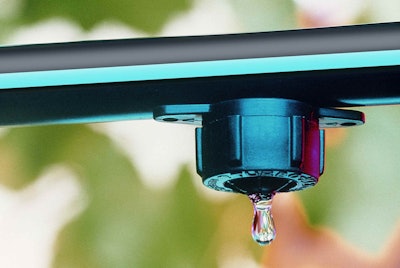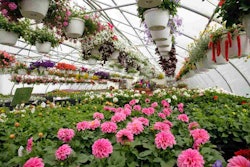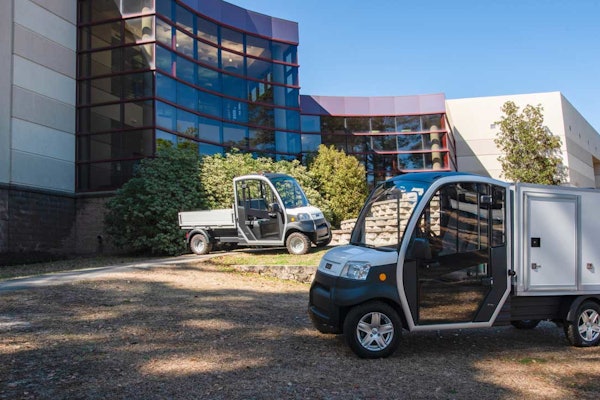 Water drips from an emitter on this irrigation system from Toro. Drip irrigation is especially effective in helping young plants become established in the landscape.
Water drips from an emitter on this irrigation system from Toro. Drip irrigation is especially effective in helping young plants become established in the landscape.Photo: Toro
Most sizable landscaping companies’ services include irrigation work, and it’s a good bet many of them have installed a so-called “drip,” or micro, irrigation system somewhere along the way.
Drip irrigation traces its origins – and most of the technology’s development since then – to the agricultural industry. It has been used in landscape applications for decades now, although it’s still more common in the Southwest and other areas with dry climates, as well as states such as Florida that have water restrictions.
Its prevalence there, of course, stems from the idea that drip irrigation saves water, at least when compared with traditional sprinkler systems. After all, isn’t saving water the main idea behind drip irrigation?
Well, it may be, but irrigation experts say the anticipated benefits of drip irrigation simply won’t be realized unless the systems are installed properly and then, just as importantly, maintained for the long term and managed closely along the way.
“It’s not best in all applications,” said Brian Vinchesi, president of Irrigation Consulting Inc., which has offices in Boston, New Jersey and Charlotte, North Carolina. “It will require more maintenance than is needed on a conventional system. And it can be more easily damaged,” especially in high-traffic areas.
Water savings are possible but not a sure thing, Vinchesi said. “It can save water if it’s scheduled properly,” he said, but it can also be “as inefficient as anything else” unless it’s monitored and managed correctly.
For example, Vinchesi noted that “a lot of people think drip puts water down very slowly, but that’s not necessarily so; but, because people think it puts water down slowly, they tend to run it too long.”
“Drip irrigation is a good option to have in your business,” Vinchesi says of landscape contractors. “It will help your business grow, but you need to make sure you know how to install and design” the systems appropriately for specific projects.
Like Vinchesi, Michael Clark, president of Clark Irrigation Design & Consulting Inc. in Lavonia, Georgia, says the success of drip irrigation systems depends not only on proper design and installation but also ongoing maintenance.
“Economically,” Clark said, “drip irrigation can make more sense – it can be less expensive.” Whether it is over time, however, depends on managing the system for the long term.
“If it’s properly installed and set to provide the correct level of water, then the plants will be healthy.” If it’s not, they won’t – and dying plants will never be economical.
For Brent Mecham, industry development director with the Irrigation Association, the success of drip irrigation depends on both close attention to mechanics – in other words, proper installation, settings and the like – but also horticultural skills.
“You need to have the horticultural knowledge in addition to the irrigation skills – knowledge of soil and plants – if you’re going to make drip irrigation effective for the long term,” Mecham said.
Micro irrigation is “precision irrigation,” he said, “and that means you need precision installation.”
Mecham said many people think drip irrigation is less expensive than traditional sprinkler systems. While that may be true for components of the system, operating it effectively – that is, providing the ongoing maintenance and management that all three experts cited as necessary – carries costs of its own.
“Efficiency is perceived,” Mecham said, “but it takes really great management to achieve it.”
And efficiency, he added, “is applying the right amount of water in the right place at the right time.” Both sprinklers and drip systems can do that, he said, but whether the latter will work well “is going to depend on the person who manages it.”









